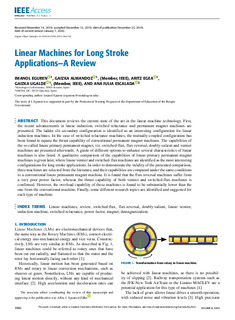| dc.rights.license | Attribution 4.0 International | * |
| dc.contributor.author | Eguren-Alustiza, Imanol | |
| dc.contributor.author | Almandoz, Gaizka | |
| dc.contributor.author | Egea, Aritz | |
| dc.contributor.author | Ugalde, Gaizka | |
| dc.contributor.other | Escalada Aguado, Ana Julia | |
| dc.date.accessioned | 2020-03-26T10:45:34Z | |
| dc.date.available | 2020-03-26T10:45:34Z | |
| dc.date.issued | 2020 | |
| dc.identifier.issn | 2169-3536 | en |
| dc.identifier.other | https://katalogoa.mondragon.edu/janium-bin/janium_login_opac.pl?find&ficha_no=154504 | en |
| dc.identifier.uri | https://hdl.handle.net/20.500.11984/1599 | |
| dc.description.abstract | This document reviews the current state of the art in the linear machine technology. First,the recent advancements in linear induction, switched reluctance and permanent magnet machines arepresented. The ladder slit secondary configuration is identified as an interesting configuration for linearinduction machines. In the case of switched reluctance machines, the mutually-coupled configuration hasbeen found to equate the thrust capability of conventional permanent magnet machines. The capabilities ofthe so called linear primary permanent magnet, viz. switched-flux, flux-reversal, doubly-salient and verniermachines are presented afterwards. A guide of different options to enhance several characteristics of linearmachines is also listed. A qualitative comparison of the capabilities of linear primary permanent magnetmachines is given later, where linear vernier and switched-flux machines are identified as the most interestingconfigurations for long stroke applications. In order to demonstrate the validity of the presented comparison,three machines are selected from the literature, and their capabilities are compared under the same conditionsto a conventional linear permanent magnet machine. It is found that the flux-reversal machines suffer froma very poor power factor, whereas the thrust capability of both vernier and switched-flux machines isconfirmed. However, the overload capability of these machines is found to be substantially lower than theone from the conventional machine. Finally, some different research topics are identified and suggested foreach type of machine. | en |
| dc.language.iso | eng | en |
| dc.publisher | IEEE | en |
| dc.rights | © los autores | en |
| dc.rights.uri | http://creativecommons.org/licenses/by/4.0/ | * |
| dc.subject | Linear machines | en |
| dc.subject | switched-flux | en |
| dc.subject | flux-reversal | en |
| dc.subject | doubly-salient | en |
| dc.subject | linear vernier | en |
| dc.subject | induction machine | en |
| dc.subject | switched-reluctance | en |
| dc.subject | power factor | en |
| dc.subject | magnet | en |
| dc.subject | demagnetization | en |
| dc.title | Linear Machines for Long Stroke Applications: a review | en |
| dc.type | http://purl.org/coar/resource_type/c_6501 | |
| dcterms.accessRights | http://purl.org/coar/access_right/c_abf2 | en |
| dcterms.source | IEEE Access | en |
| local.description.peerreviewed | true | en |
| local.identifier.doi | https://dx.doi.org/10.1109/ACCESS.2019.2961758 | en |
| local.contributor.otherinstitution | Orona EIC | es |
| local.source.details | Vol. 8. Pp. 3960-3979, 2020 | eu_ES |
| oaire.format.mimetype | application/pdf | |
| oaire.file | $DSPACE\assetstore | |
| oaire.resourceType | http://purl.org/coar/resource_type/c_6501 | en |
| oaire.version | http://purl.org/coar/version/c_970fb48d4fbd8a85 | en |








